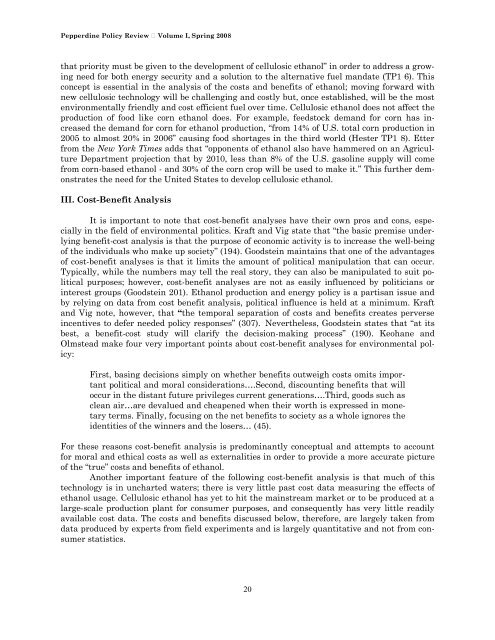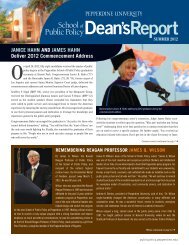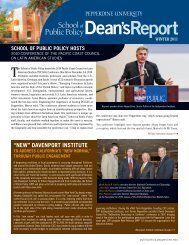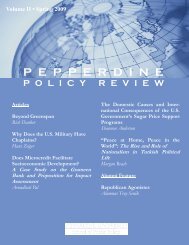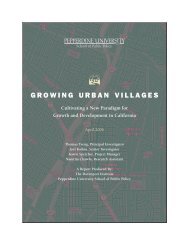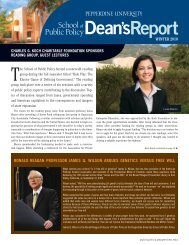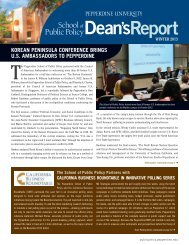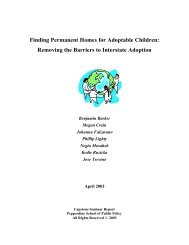Pepperdine University School of Public Policy
Pepperdine University School of Public Policy
Pepperdine University School of Public Policy
Create successful ePaper yourself
Turn your PDF publications into a flip-book with our unique Google optimized e-Paper software.
<strong>Pepperdine</strong> <strong>Policy</strong> Review Volume I, Spring 2008<br />
that priority must be given to the development <strong>of</strong> cellulosic ethanol” in order to address a growing<br />
need for both energy security and a solution to the alternative fuel mandate (TP1 6). This<br />
concept is essential in the analysis <strong>of</strong> the costs and benefits <strong>of</strong> ethanol; moving forward with<br />
new cellulosic technology will be challenging and costly but, once established, will be the most<br />
environmentally friendly and cost efficient fuel over time. Cellulosic ethanol does not affect the<br />
production <strong>of</strong> food like corn ethanol does. For example, feedstock demand for corn has increased<br />
the demand for corn for ethanol production, “from 14% <strong>of</strong> U.S. total corn production in<br />
2005 to almost 20% in 2006” causing food shortages in the third world (Hester TP1 8). Etter<br />
from the New York Times adds that “opponents <strong>of</strong> ethanol also have hammered on an Agriculture<br />
Department projection that by 2010, less than 8% <strong>of</strong> the U.S. gasoline supply will come<br />
from corn-based ethanol - and 30% <strong>of</strong> the corn crop will be used to make it.” This further demonstrates<br />
the need for the United States to develop cellulosic ethanol.<br />
III. Cost-Benefit Analysis<br />
It is important to note that cost-benefit analyses have their own pros and cons, especially<br />
in the field <strong>of</strong> environmental politics. Kraft and Vig state that “the basic premise underlying<br />
benefit-cost analysis is that the purpose <strong>of</strong> economic activity is to increase the well-being<br />
<strong>of</strong> the individuals who make up society” (194). Goodstein maintains that one <strong>of</strong> the advantages<br />
<strong>of</strong> cost-benefit analyses is that it limits the amount <strong>of</strong> political manipulation that can occur.<br />
Typically, while the numbers may tell the real story, they can also be manipulated to suit political<br />
purposes; however, cost-benefit analyses are not as easily influenced by politicians or<br />
interest groups (Goodstein 201). Ethanol production and energy policy is a partisan issue and<br />
by relying on data from cost benefit analysis, political influence is held at a minimum. Kraft<br />
and Vig note, however, that “the temporal separation <strong>of</strong> costs and benefits creates perverse<br />
incentives to defer needed policy responses” (307). Nevertheless, Goodstein states that “at its<br />
best, a benefit-cost study will clarify the decision-making process” (190). Keohane and<br />
Olmstead make four very important points about cost-benefit analyses for environmental policy:<br />
First, basing decisions simply on whether benefits outweigh costs omits important<br />
political and moral considerations….Second, discounting benefits that will<br />
occur in the distant future privileges current generations….Third, goods such as<br />
clean air…are devalued and cheapened when their worth is expressed in monetary<br />
terms. Finally, focusing on the net benefits to society as a whole ignores the<br />
identities <strong>of</strong> the winners and the losers… (45).<br />
For these reasons cost-benefit analysis is predominantly conceptual and attempts to account<br />
for moral and ethical costs as well as externalities in order to provide a more accurate picture<br />
<strong>of</strong> the “true” costs and benefits <strong>of</strong> ethanol.<br />
Another important feature <strong>of</strong> the following cost-benefit analysis is that much <strong>of</strong> this<br />
technology is in uncharted waters; there is very little past cost data measuring the effects <strong>of</strong><br />
ethanol usage. Cellulosic ethanol has yet to hit the mainstream market or to be produced at a<br />
large-scale production plant for consumer purposes, and consequently has very little readily<br />
available cost data. The costs and benefits discussed below, therefore, are largely taken from<br />
data produced by experts from field experiments and is largely quantitative and not from consumer<br />
statistics.<br />
20


